High-Branched Organosilicon Epoxy Resin with Low Viscosity, Excellent Toughness, Hydrophobicity, and Dielectric Property
Abstract
:1. Introduction
2. Results
2.1. Structural Characterizations
2.2. Viscosity-Reducing Ability
2.3. Thermal Stability
2.4. Mechanical Properties
2.5. Hydrophobic Properties
2.6. Dielectric Properties
3. Materials and Methods
3.1. Materials
3.2. Synthesis of QSiE
3.3. Preparation of Cured Thermosets
3.4. Characterization
4. Conclusions
Author Contributions
Funding
Institutional Review Board Statement
Informed Consent Statement
Data Availability Statement
Acknowledgments
Conflicts of Interest
References
- Auvergne, R.; Caillol, S.; David, G.; Boutevin, B.; Pascault, J. Biobased thermosetting epoxy: Present and future. Chem. Rev. 2014, 114, 1082–1115. [Google Scholar] [CrossRef]
- Zhang, J.; Mi, X.; Chen, S.; Xu, Z.; Zhang, D.; Miao, M.; Wang, J. A bio-based hyperbranched flame retardant for epoxy resins. Chem. Eng. J. 2020, 381, 122719. [Google Scholar] [CrossRef]
- Kumar, S.; Krishnan, S.; Mohanty, S.; Nayak, S.K. Synthesis and characterization of petroleum and biobased epoxy resins: A review. Polym. Int. 2018, 67, 815–839. [Google Scholar] [CrossRef]
- Jiang, G.; Xiao, Y.; Qian, Z.; Yang, Y.; Jia, P.; Song, L.; Hu, Y.; Ma, C.; Gui, Z. A novel phosphorus-, nitrogen- and sulfur-containing macromolecule flame retardant for constructing high-performance epoxy resin composites. Chem. Eng. J. 2023, 451, 137823. [Google Scholar] [CrossRef]
- Mi, X.; Liang, N.; Xu, H.; Wu, J.; Jiang, Y.; Nie, B.; Zhang, D. Toughness and its mechanisms in epoxy resins. Prog. Mater. Sci. 2022, 130, 100977. [Google Scholar] [CrossRef]
- Zhang, T.; Yu, C.; Yu, M.; Huang, Y.; Tan, J.; Zhang, M.; Zhu, X. Multifunctional tannin extract-based epoxy derived from waste bark as a highly toughening and strengthening agent for epoxy resin. Ind. Crops Prod. 2022, 176, 114255. [Google Scholar] [CrossRef]
- Miao, X.; Meng, Y.; Li, X. A novel all-purpose epoxy-terminated hyperbranched polyether sulphone toughener for an epoxy/amine system. Polymer 2015, 60, 88–95. [Google Scholar] [CrossRef]
- Guo, W.; Wang, X.; Huang, J.; Mu, X.; Cai, W.; Song, L.; Hu, Y. Phosphorylated cardanol-formaldehyde oligomers as flame-retardant and toughening agents for epoxy thermosets. Chem. Eng. J. 2021, 423, 130192. [Google Scholar] [CrossRef]
- Zhang, X.; Wang, Z.; Ding, M.; Feng, Y.; Yao, J. Advances in cellulose-metal organic framework composites: Preparation and applications. J. Mater. Chem. A 2021, 9, 23353–23363. [Google Scholar] [CrossRef]
- Lee, M.; Paria, S.; Mondal, S.; Lee, G.; Shin, B.; Kim, S.; Park, S.; Nah, C. Amphiphilic block co-polymer and silica reinforced epoxy composite with excellent toughness and delamination resistance for durable electronic packaging application. Polymer 2022, 245, 124679. [Google Scholar] [CrossRef]
- Yu, M.; Zhang, T.; Li, J.; Tan, J.; Zhu, X. Enhancing toughness, flame retardant, hydrophobic and dielectric properties of epoxy resin by incorporating multifunctional additive containing phosphorus/silicon. Mater. Des. 2023, 225, 111529. [Google Scholar] [CrossRef]
- Liu, X.; Xiao, Y.; Luo, X.; Liu, B.; Guo, D.; Chen, L.; Wang, Y. Flame-retardant multifunctional epoxy resin with high performances. Chem. Eng. J. 2022, 427, 132031. [Google Scholar] [CrossRef]
- Yang, L.; Li, Y.; Du, M.; He, Y.; Lan, Y.; Yin, Q.; Zhu, F.; Chang, G. Force-reversible and energetic indole-mg-indole cation-π interaction for designing toughened and multifunctional high-performance thermosets. Adv. Funct. Mater. 2022, 32, 2111021. [Google Scholar] [CrossRef]
- Wu, M.; Liu, X.; Zhou, Y.; Fu, L.; Pan, J.; Cao, B.; Liu, S.; Zhao, J.; Xie, W. Fluorinated anhydride-terminated imide oligomers toward high-performance epoxy thermosets enabled by hydroxyl elimination and low dielectric polarizability strategy. Chem. Eng. J. 2022, 437, 135435. [Google Scholar] [CrossRef]
- Zhang, W.; Camino, G.; Yang, R. Polymer/polyhedral oligomeric silsesquioxane (poss) nanocomposites: An overview of fire retardance. Prog. Polym. Sci. 2017, 67, 77–125. [Google Scholar] [CrossRef]
- Ye, X.M.; Li, J.J.; Zhang, W.C.; Yang, R.J.; Li, J.R. Fabrication of eco-friendly and multifunctional sodium-containing polyhedral oligomeric silsesquioxane and its flame retardancy on epoxy resin. Compos. Part B-Eng. 2020, 191, 107961. [Google Scholar] [CrossRef]
- Li, S.; Liu, Y.; Liu, Y.; Wang, Q. Synergistic effect of piperazine pyrophosphate and epoxy-octavinyl silsesquioxane on flame retardancy and mechanical properties of epoxy resin. Compos. Part B Eng. 2021, 223, 109115. [Google Scholar] [CrossRef]
- Zhang, W.; Zhang, W.; Pan, Y.; Yang, R. Facile synthesis of transition metal containing polyhedral oligomeric silsesquioxane complexes with mesoporous structures and their applications in reducing fire hazards, enhancing mechanical and dielectric properties of epoxy composites. J. Hazard. Mater. 2021, 401, 123439. [Google Scholar] [CrossRef]
- Liu, R.; Yan, H.; Zhang, Y.; Yang, K.; Du, S. Cyanate ester resins containing si-o-c hyperbranched polysiloxane with favorable curing processability and toughness for electronic packaging. Chem. Eng. J. 2022, 433, 133827. [Google Scholar] [CrossRef]
- Shi, Y.; Ma, B.; Guan, J.; Ye, B.; Yu, L.; Wu, Z.; Shen, X.; Habaue, S. Rational design of a functionalized silicone polymer for modifying epoxy-based composites. J. Mater. Res. Technol. 2022, 19, 3867–3876. [Google Scholar] [CrossRef]
- Zheng, J.; Cai, Y.; Hu, Y.; Zhu, J.; Wei, J.; Ma, Y.; Wan, J.; Fan, H. Bio-based epoxy functionalized mq silicone resins: From synthesis to toughened epoxy composites with good mechanical properties, thermal resistance and transparency. Polym. Chem. 2022, 13, 5325–5336. [Google Scholar] [CrossRef]
- Tian, Y.; Wang, Q.; Shen, L.; Cui, Z.; Kou, L.; Cheng, J.; Zhang, J. A renewable resveratrol-based epoxy resin with high tg, excellent mechanical properties and low flammability. Chem. Eng. J. 2020, 383, 123124. [Google Scholar] [CrossRef]
- Chen, Y.; Ji, S.; Sun, W.; Chen, W.; Dong, J.; Wen, J.; Zhang, J.; Li, Z.; Zheng, L.; Chen, C.; et al. Discovering partially charged single-atom pt for enhanced anti-markovnikov alkene hydrosilylation. J. Am. Chem. Soc. 2018, 140, 7407–7410. [Google Scholar] [CrossRef] [PubMed]
- Ozeren Ozgul, E.; Ozkul, M.H. Effects of epoxy, hardener, and diluent types on the workability of epoxy mixtures. Constr. Build. Mater. 2018, 158, 369–377. [Google Scholar] [CrossRef]
- Jiang, S.; Tang, G.; Chen, J.; Huang, Z.; Hu, Y. Biobased polyelectrolyte multilayer-coated hollow mesoporous silica as a green flame retardant for epoxy resin. J. Hazard. Mater. 2018, 342, 689–697. [Google Scholar] [CrossRef]
- Qi, Y.; Weng, Z.; Kou, Y.; Song, L.; Li, J.; Wang, J.; Zhang, S.; Liu, C.; Jian, X. Synthesize and introduce bio-based aromatic s-triazine in epoxy resin: Enabling extremely high thermal stability, mechanical properties, and flame retardancy to achieve high-performance sustainable polymers. Chem. Eng. J. 2021, 406, 126881. [Google Scholar] [CrossRef]
- Teng, N.; Dai, J.; Wang, S.; Hu, J.; Liu, X. Hyperbranched flame retardant for epoxy resin modification: Simultaneously improved flame retardancy, toughness and strength as well as glass transition temperature. Chem. Eng. J. 2022, 428, 131226. [Google Scholar] [CrossRef]
- Yang, G.; Wu, W.; Wang, Y.; Jiao, Y.; Lu, L.; Qu, H.; Qin, X. Synthesis of a novel phosphazene-based flame retardant with active amine groups and its application in reducing the fire hazard of epoxy resin. J. Hazard. Mater. 2019, 366, 78–87. [Google Scholar] [CrossRef]
- Duan, H.; Chen, Y.; Ji, S.; Hu, R.; Ma, H. A novel phosphorus/nitrogen-containing polycarboxylic acid endowing epoxy resin with excellent flame retardance and mechanical properties. Chem. Eng. J. 2019, 375, 121916. [Google Scholar] [CrossRef]
- Feng, J.; Ma, Z.; Xu, Z.; Xie, H.; Lu, Y.; Maluk, C.; Song, P.; Bourbigot, S.; Wang, H. A si-containing polyphosphoramide via green chemistry for fire-retardant polylactide with well-preserved mechanical and transparent properties. Chem. Eng. J. 2022, 431, 134259. [Google Scholar] [CrossRef]
- Lu, Q.; Dong, L.; Chen, L.; Fu, J.; Shi, L.; Li, M.; Zeng, X.; Lei, H.; Zheng, F. Inorganic-organic gel electrolytes with 3d cross-linking star-shaped structured networks for lithium ion batteries. Chem. Eng. J. 2020, 393, 124708. [Google Scholar] [CrossRef]
- Wright, W.W. The effect of diffusion of water into epoxy resins and their carbon-fibre reinforced composites. Composites 1981, 12, 201–205. [Google Scholar] [CrossRef]
- Peng, X.; Li, Z.; Wang, D.; Li, Z.; Liu, C.; Wang, R.; Jiang, L.; Liu, Q.; Zheng, P. A facile crosslinking strategy endows the traditional additive flame retardant with enormous flame retardancy improvement. Chem. Eng. J. 2021, 424, 130404. [Google Scholar] [CrossRef]
- Zhang, X.; Song, L.; Chen, X.; Wang, Y.; Feng, Y.; Yao, J. Zirconium ion modified melamine sponge for oil and organic solvent cleanup. J. Colloid Interf. Sci. 2020, 566, 242–247. [Google Scholar] [CrossRef]
- Wang, F.; Li, J.; Pi, J.; Song, F.; Luo, Y.; Wang, X.; Wang, Y. Superamphiphobic and flame-retardant coatings with highly chemical and mechanical robustness. Chem. Eng. J. 2021, 421, 127793. [Google Scholar] [CrossRef]
- Wang, H.; Yuan, J.; Zhu, Z.; Yin, X.; Weng, Y.; Wang, Z.; Yang, F.; Zhan, J.; Wang, H.; Wang, L. High performance epoxy resin composites modified with multifunctional thiophene/phosphaphenanthrene-based flame retardant: Excellent flame retardance, strong mechanical property and high transparency. Compos. Part B Eng. 2021, 227, 109392. [Google Scholar] [CrossRef]
- Jia, Y.; Yang, J.; Ma, H.; Li, B. Preparation of silicon-containing epoxy monomers with different structure and their effects on thermal conductivity of epoxy resin. Polym. Bull. 2021, 79, 9043–9058. [Google Scholar] [CrossRef]
- Cheng, J.; Wang, J.; Yang, S.; Zhang, Q.; Huo, S.; Zhang, Q.; Hu, Y.; Ding, G. Benzimidazolyl-substituted cyclotriphosphazene derivative as latent flame-retardant curing agent for one-component epoxy resin system with excellent comprehensive performance. Compos. Part B Eng. 2019, 177, 107440. [Google Scholar] [CrossRef]

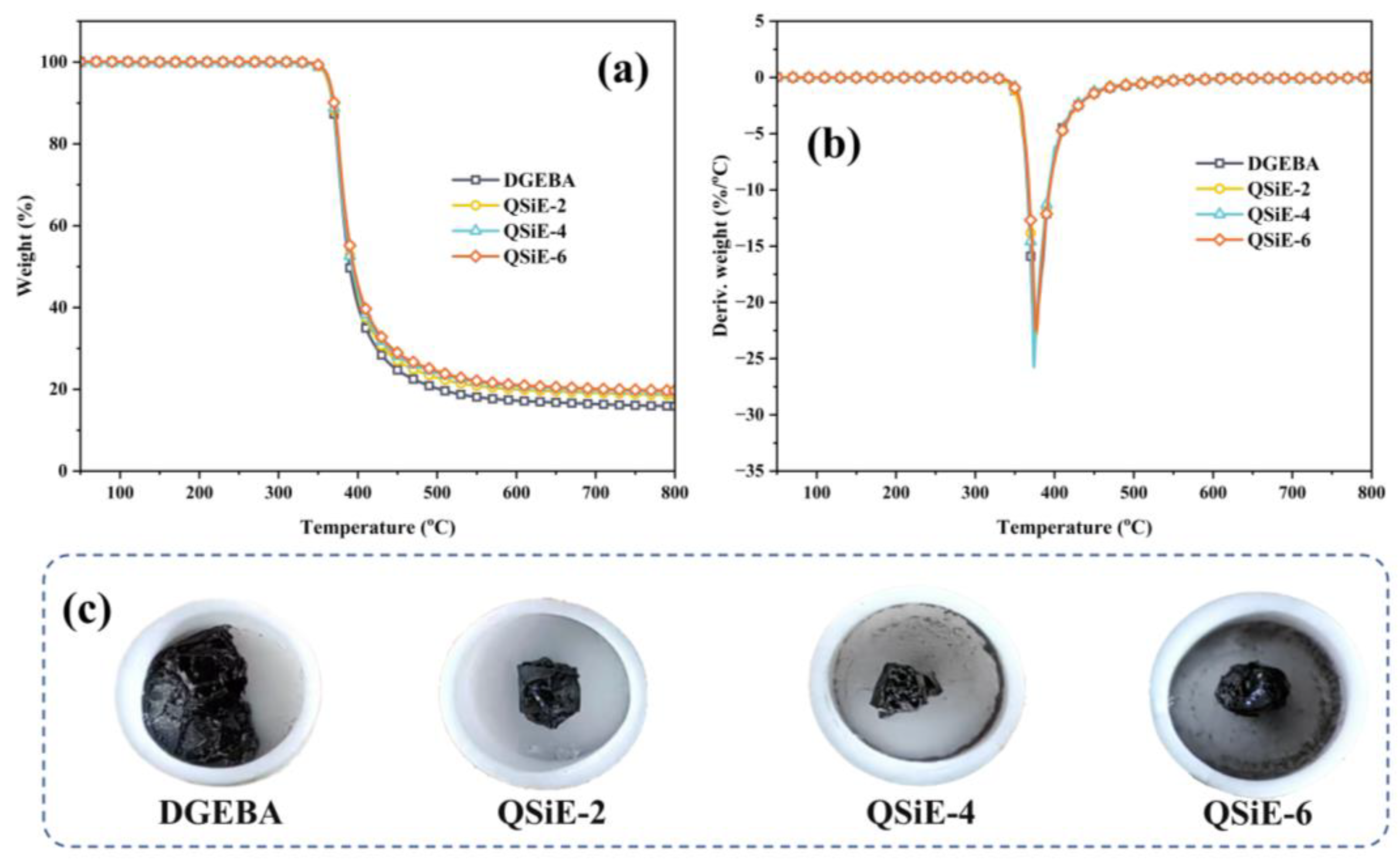
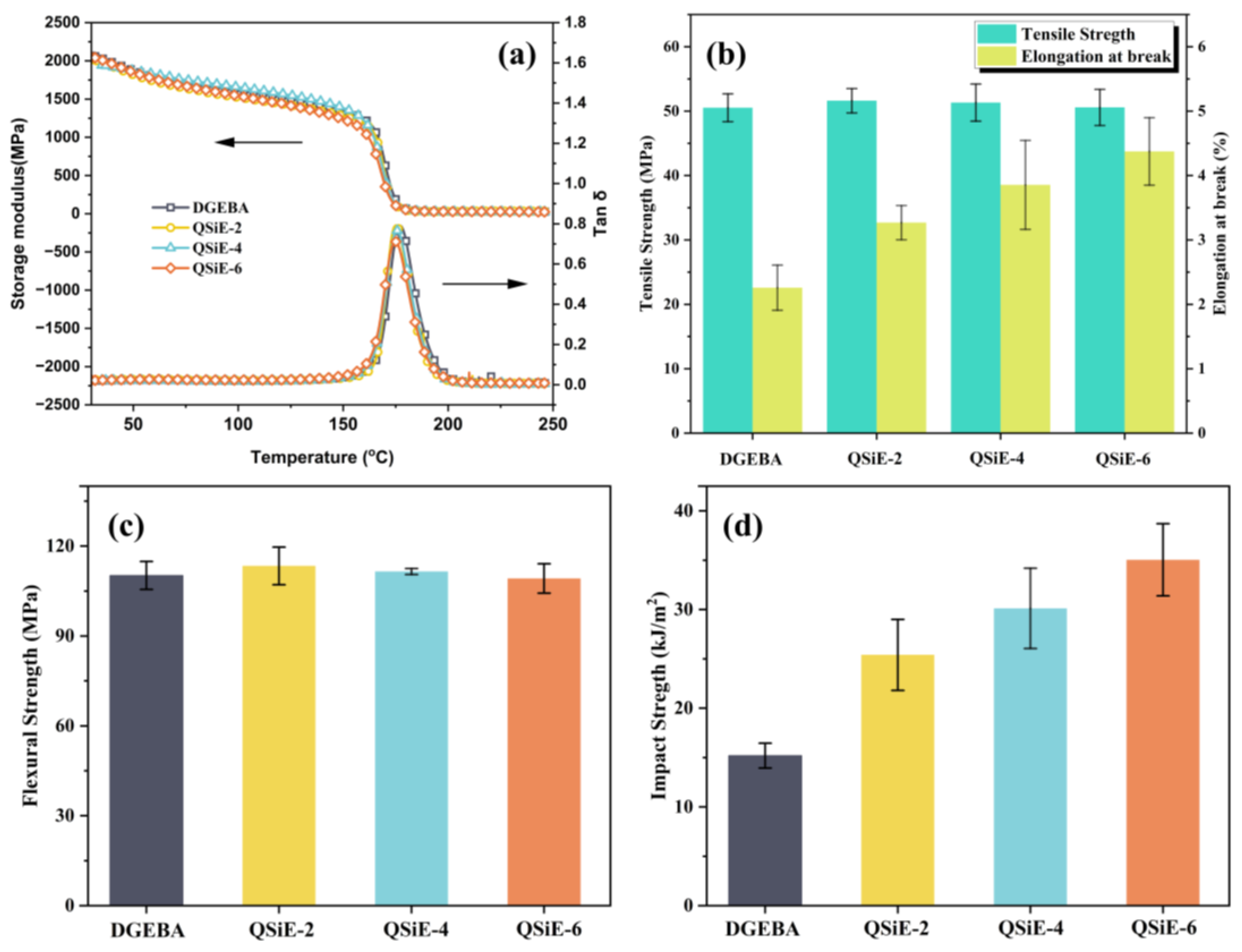
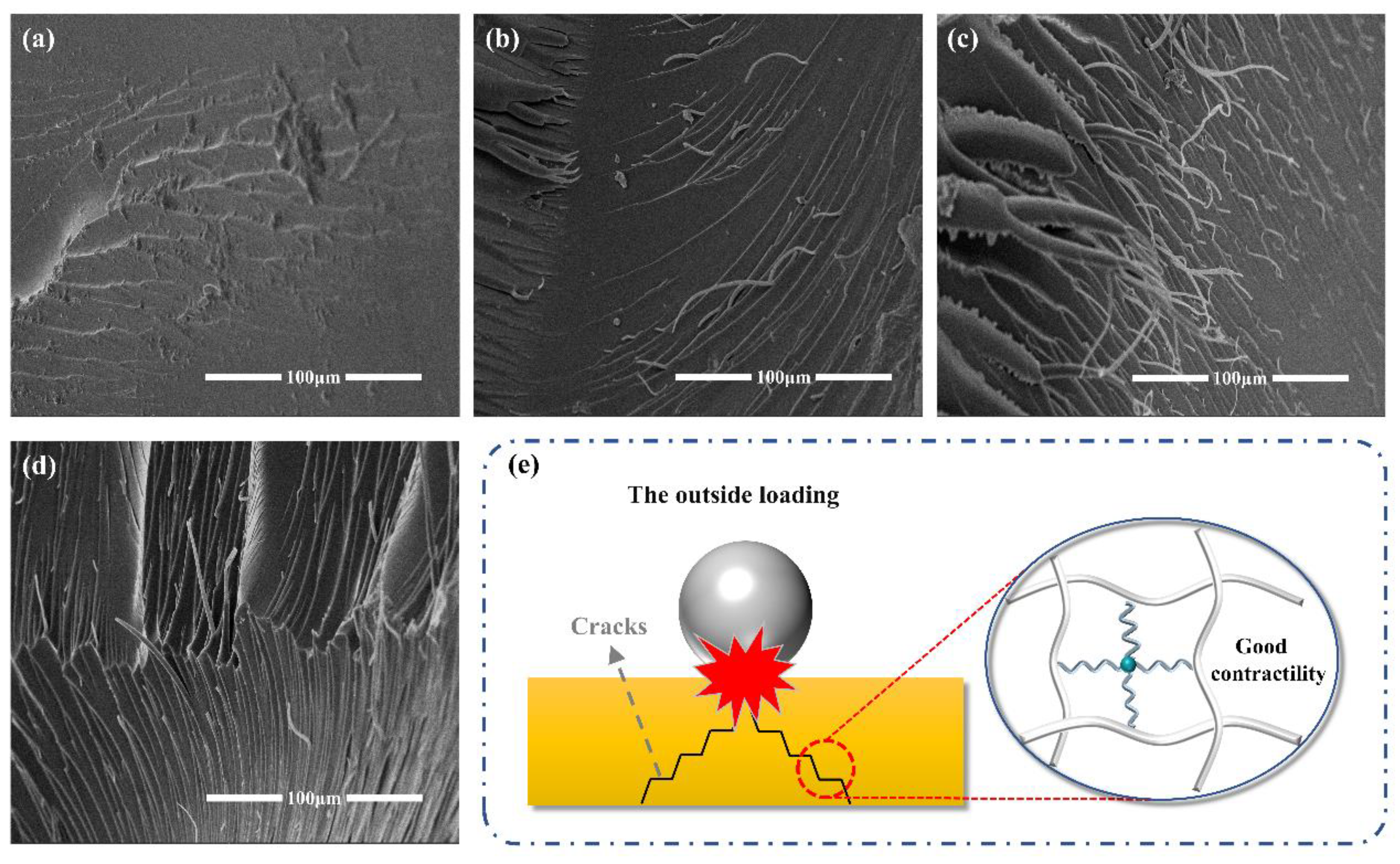
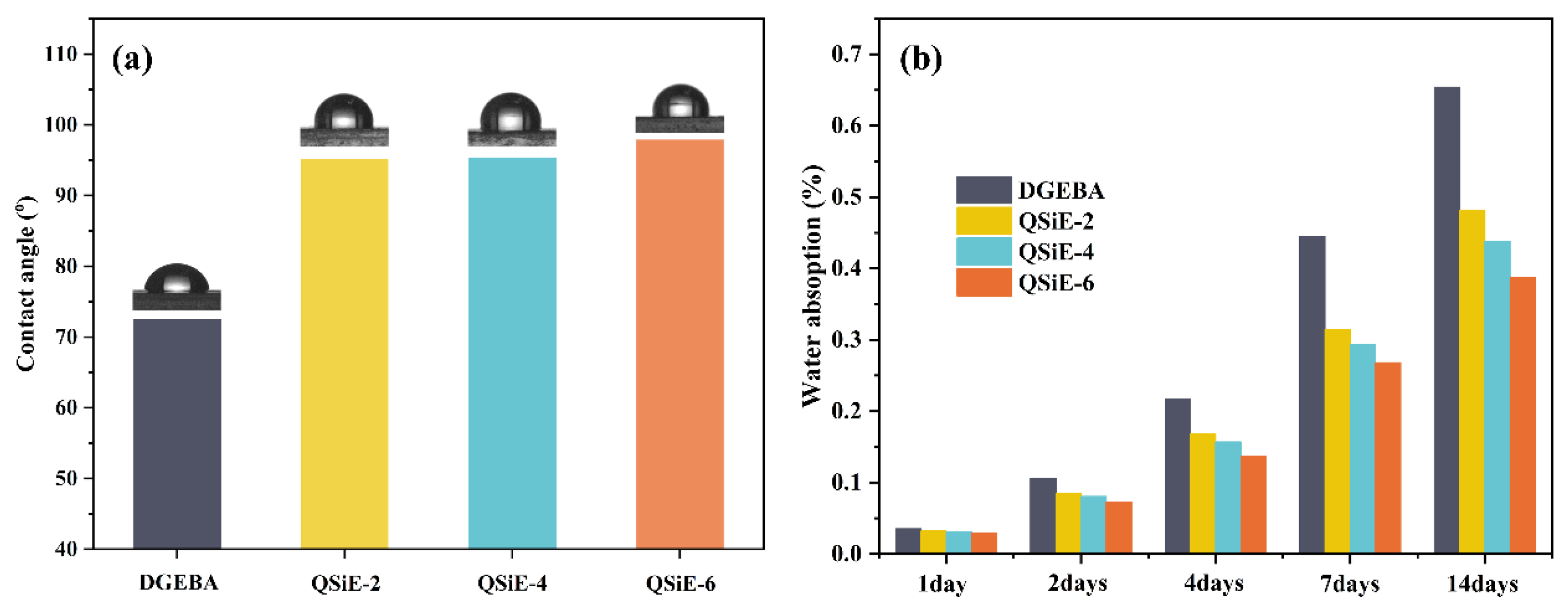
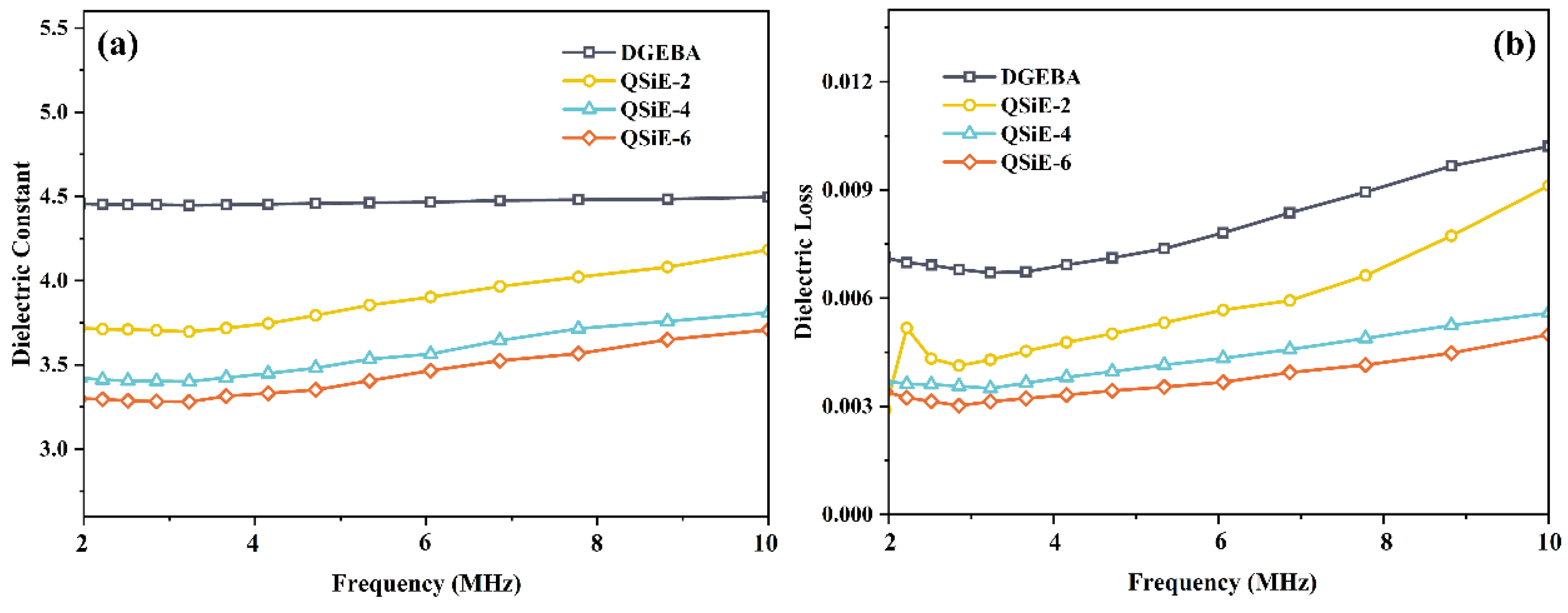
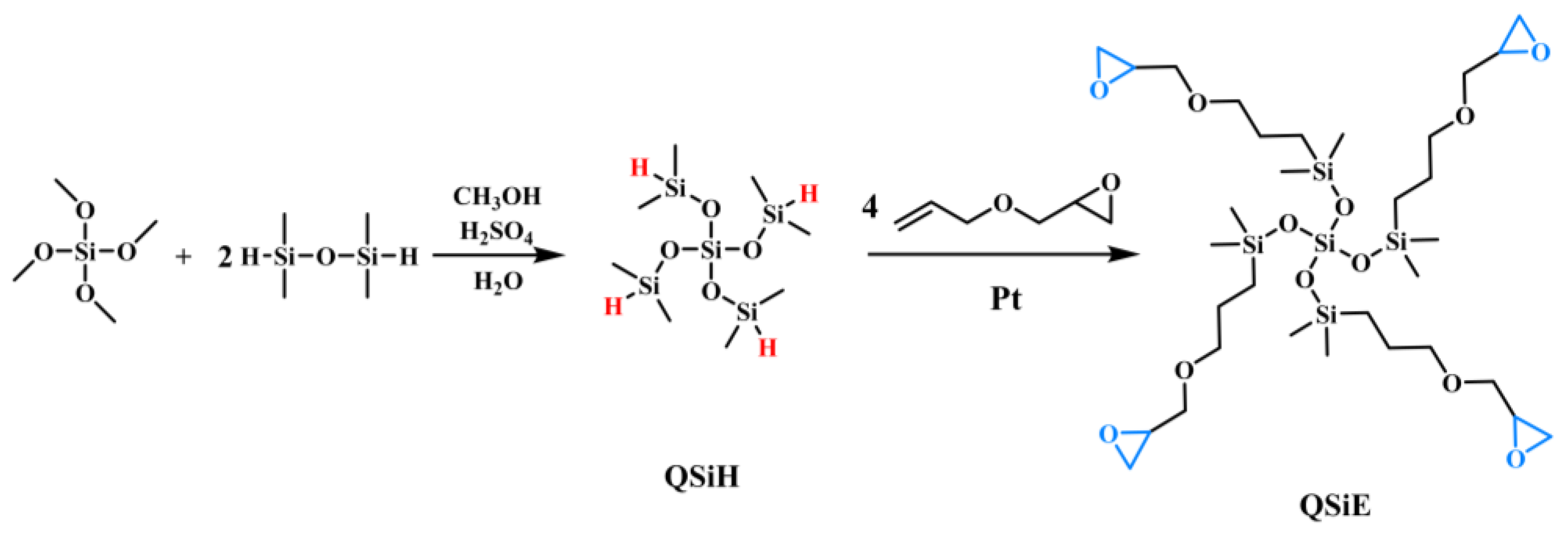
| Sample | T10% (°C) | Tmax (°C) | Cy800 (%) |
|---|---|---|---|
| DGEBA | 368.1 | 374.4 | 15.9 |
| QSiE-2 | 368.7 | 376.0 | 18.7 |
| QSiE-4 | 369.1 | 374.0 | 19.5 |
| QSiE-6 | 369.9 | 376.8 | 19.7 |
| Sample | Tg (°C) | Storage Modulus at 35 °C (MPa) | νe (×103 mol/m3) |
|---|---|---|---|
| DGEBA | 177.4 | 2033.7 | 2.32 |
| QSiE-2 | 175.1 | 1978.9 | 2.56 |
| QSiE-4 | 175.9 | 1943.1 | 2.29 |
| QSiE-6 | 174.9 | 2012.1 | 2.34 |
| Sample | QSiE Content (%) | DGEBA (g) | QSiE (g) | DDM (g) |
|---|---|---|---|---|
| DGEBA | 0 | 100 | / | 25.77 |
| QSiE-2 | 2 | 100 | 2 | 26.28 |
| QSiE-4 | 4 | 100 | 4 | 26.78 |
| QSiE-6 | 6 | 100 | 6 | 27.29 |
Disclaimer/Publisher’s Note: The statements, opinions and data contained in all publications are solely those of the individual author(s) and contributor(s) and not of MDPI and/or the editor(s). MDPI and/or the editor(s) disclaim responsibility for any injury to people or property resulting from any ideas, methods, instructions or products referred to in the content. |
© 2023 by the authors. Licensee MDPI, Basel, Switzerland. This article is an open access article distributed under the terms and conditions of the Creative Commons Attribution (CC BY) license (https://creativecommons.org/licenses/by/4.0/).
Share and Cite
Yu, M.; Chen, Z.; Li, J.; Tan, J.; Zhu, X. High-Branched Organosilicon Epoxy Resin with Low Viscosity, Excellent Toughness, Hydrophobicity, and Dielectric Property. Molecules 2023, 28, 2826. https://doi.org/10.3390/molecules28062826
Yu M, Chen Z, Li J, Tan J, Zhu X. High-Branched Organosilicon Epoxy Resin with Low Viscosity, Excellent Toughness, Hydrophobicity, and Dielectric Property. Molecules. 2023; 28(6):2826. https://doi.org/10.3390/molecules28062826
Chicago/Turabian StyleYu, Min, Zeyuan Chen, Jie Li, Jihuai Tan, and Xinbao Zhu. 2023. "High-Branched Organosilicon Epoxy Resin with Low Viscosity, Excellent Toughness, Hydrophobicity, and Dielectric Property" Molecules 28, no. 6: 2826. https://doi.org/10.3390/molecules28062826
APA StyleYu, M., Chen, Z., Li, J., Tan, J., & Zhu, X. (2023). High-Branched Organosilicon Epoxy Resin with Low Viscosity, Excellent Toughness, Hydrophobicity, and Dielectric Property. Molecules, 28(6), 2826. https://doi.org/10.3390/molecules28062826





